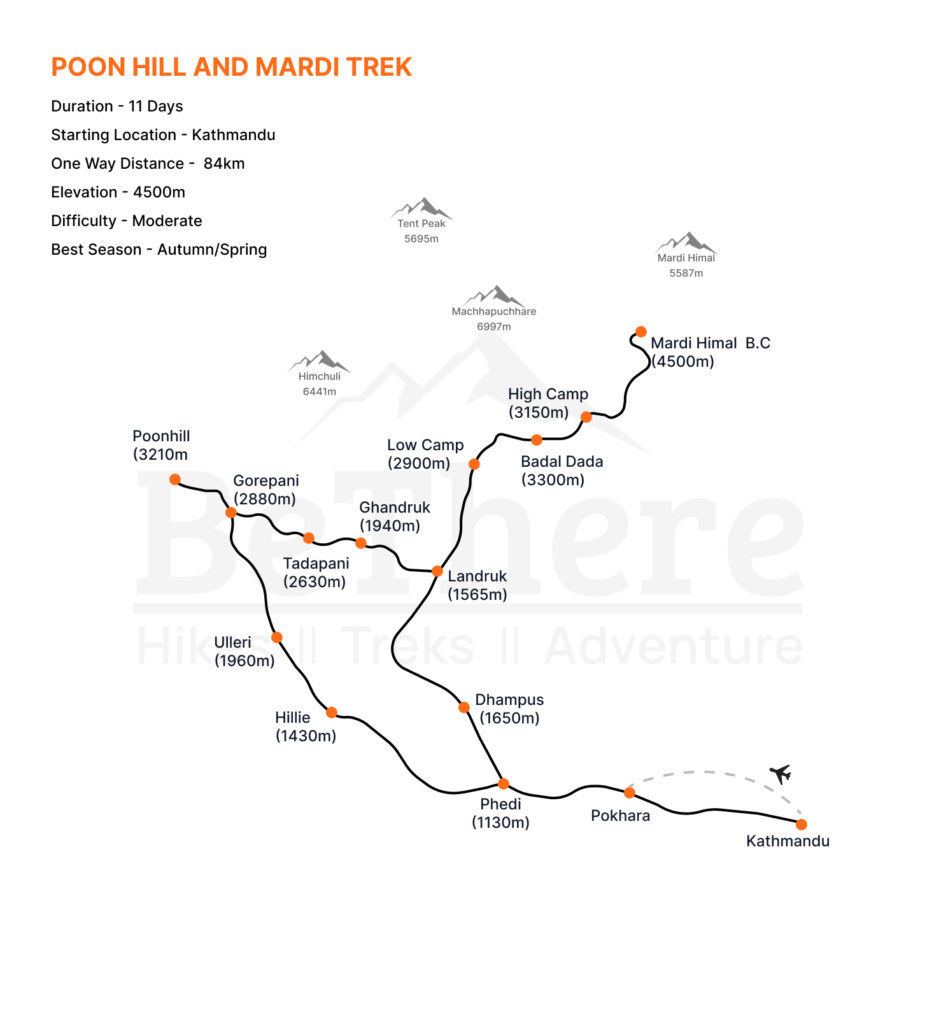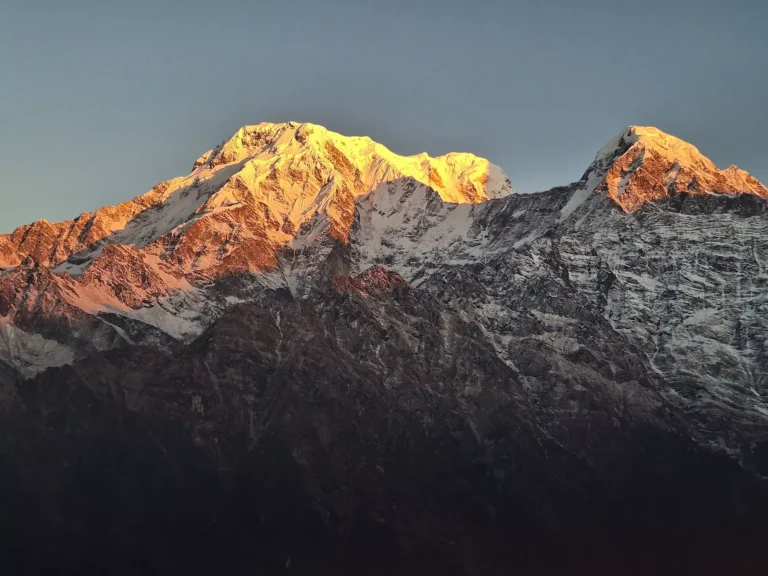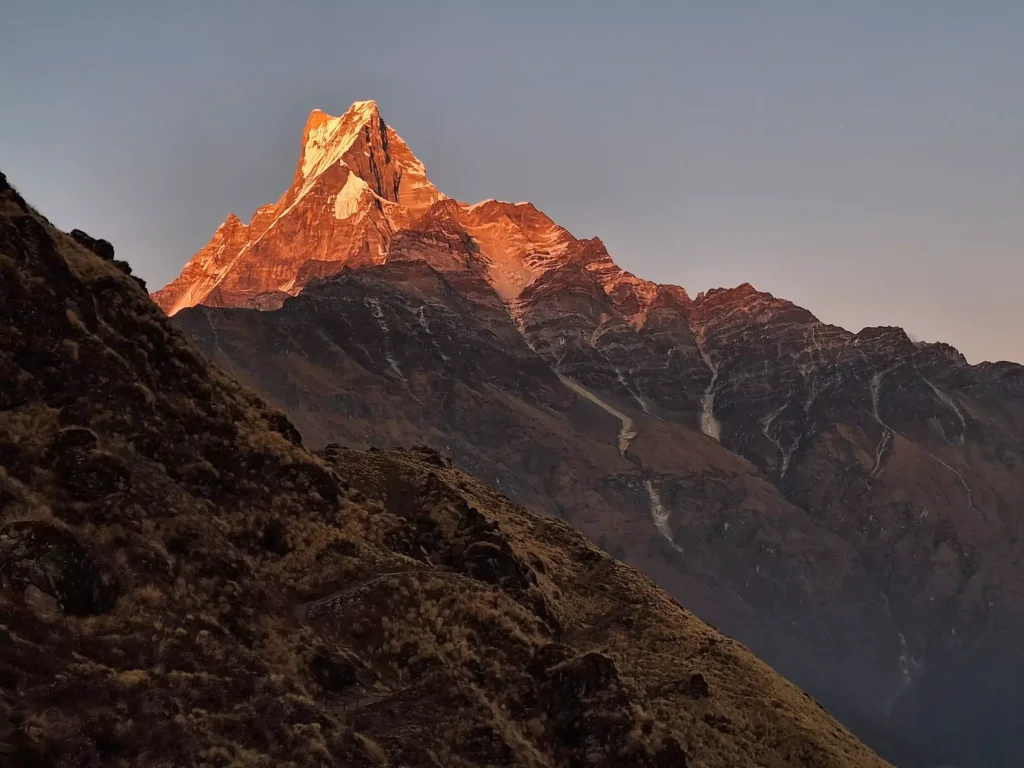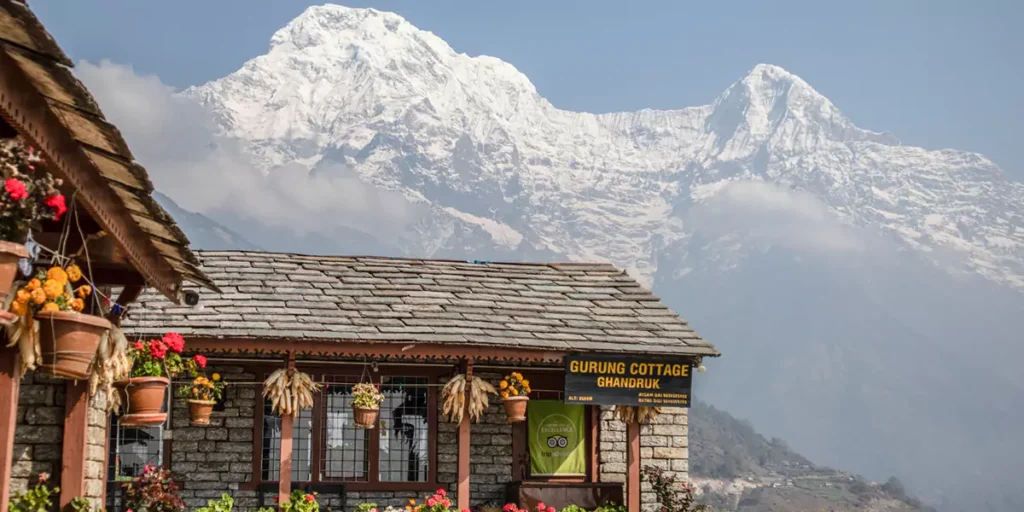Poon Hill and Mardi Himal trek
- Annapurna Conservation Area, Nepal - Show on map
- 11 Days
Duration
11 Days
Max. Altitude
4500m
Difficulty Level
Moderate
One Way Distance
84Km
Start/End Point
Kathmandu
Best Season
Autumn/Spring
Duration
11 Days
Max. Altitude
4500m
Difficulty Level
Moderate
One Way Distance
84Km
Start/End Point
Kathmandu
Best Season
Autumn/Spring
Poon Hill and Mardi Himal Trek Overview
The Poon Hill and Mardi Himal Trek is a scenic and moderately challenging adventure that combines two of Nepal’s most breathtaking short treks into one seamless journey. This well-rounded trek blends the iconic sunrise view from Poon Hill with the lesser-known but equally stunning Mardi Himal Base Camp, making it ideal for both first-time hikers and experienced trekkers seeking variety without extreme altitude or technical difficulty. Typically completed in 11 days, the trek starts in the lush foothills of the mountains and ascends gradually through terraced farmlands, rhododendron forests, and alpine ridgelines to altitudes of up to 4,500 meters at Mardi Himal Base Camp. With moderate difficulty, the route is accessible to most physically fit individuals, requiring no prior high-altitude experience or climbing skills.
The Poon Hill section offers one of Nepal’s most accessible yet stunning Himalayan panoramas at 3,210 m, with sweeping views of the Dhaulagiri Himal to the west and the Annapurna Massif to the east. The sunrise paints peaks like Dhaulagiri I (8,167 m), Annapurna I (8,091 m), Machhapuchhre (6,993 m), Annapurna South (7,219 m), and Hiunchuli (6,441 m) in warm hues. The trail passes through rhododendron and oak forests, traditional Gurung and Magar villages, and terraced farmland. With moderate difficulty and well-maintained paths, this trek portion is ideal for those seeking breathtaking scenery and manageable daily distances.
The Mardi Himal section offers a more remote, high-altitude wilderness experience. Trekkers follow ridges above the clouds with uninterrupted views of Machhapuchhre (Fishtail), Annapurna’s south face, and Hiunchuli. Mardi Himal View Point (4,250 m) and Mardi Base Camp (4,500 m) reveal a vast amphitheater of snow-capped peaks, glaciers, and rugged slopes. The trail crosses grassy meadows and exposed ridges, perfect for dramatic photography. With fewer visitors, this part provides a peaceful, immersive Himalayan adventure showcasing the raw grandeur of the mountains.
Unlike busier treks like Annapurna Base Camp or Everest Base Camp, this route offers a quieter, more peaceful Himalayan experience. You’ll stay in traditional teahouses, meet welcoming Gurung and Magar communities, and pass through diverse landscapes, from subtropical forests to alpine terrain. Perfect for those seeking a rich cultural and scenic trek without extreme altitude or long duration, the Poon Hill and Mardi Himal Trek balances accessibility, cultural immersion, and stunning mountain views.
Highlights of Poon Hill and Mardi Himal trek
- Breathtaking views of Annapurna South, Hiunchuli, and the iconic Machhapuchhre (Fishtail).
- Walking through lush rhododendron and oak forests alongside traditional Gurung and Magar villages.
- Witnessing the sunrise from Poon Hill at 3,210 m with 360° Himalayan panoramas.
- Exploring the quieter, off-the-beaten-path trails of Mardi Himal beyond the crowds.
- Stunning close-up vistas of Mardi Himal’s south face framed by surrounding peaks.
- Interacting with local Gurung communities to learn about their culture and mountain lifestyle.
- Trek through vibrant rhododendron and wildflower meadows carpeting the slopes en route to Poon Hill.
- Ideal for both beginners and experienced trekkers
Poon Hill and Mardi Himal trek Itinerary
Day 01Arrive in Kathmandu (1,400 m)
Upon arrival at Tribhuvan International Airport, our representative will greet you with a signboard and transfer you by private vehicle to your hotel in Thamel, Kathmandu’s bustling tourist hub. After checking in, you can rest or explore the lively streets filled with colorful shops, local eateries, and ancient temples. Depending on your arrival time, you may also visit Kathmandu Durbar Square or enjoy traditional Nepali cuisine.
Day 02Fly to Pokhara, drive to Hile (1,430 m) and trek to Banthanti (2,150 m)
Start the day with an early flight to Pokhara, offering stunning aerial views of Manaslu, Annapurna, and Dhaulagiri. From Pokhara, a scenic 3.5-hour drive takes you to Hile, winding through terraced farmland and forested hills. Your trek begins here with a gentle 4 km uphill walk through lush subtropical forest, crossing streams and villages before reaching Banthanti (2,150 m), where you’ll spend your first night in a cozy teahouse.
Day 03Trek from Banthanti to Nangethanti to Ghorepani (2,840 m)
After breakfast, the trail climbs gradually through rhododendron, oak, and pine forests, especially vibrant in spring. You’ll pass Nangethanti (2,460 m), a common stop for tea or lunch, then continue for 2–3 hours to Ghorepani (2,840 m), a colorful Gurung village known for panoramic views. Today’s trek covers about 8 km and takes 4–5 hours, with increasing glimpses of the snow-capped Annapurna and Dhaulagiri ranges as you ascend.
Day 04Hike up to Poon Hill (3,210 m) and trek to Tadapani (2,610 m)
Before dawn, begin the iconic 45-minute stone-step climb to Poon Hill (3,210 m), one of the most celebrated viewpoints in the Annapurna region. As the first light spreads across the horizon, watch the snow-clad giants Annapurna I (8,091 m), Dhaulagiri (8,167 m), Machhapuchhre (6,993 m), Annapurna South (7,219 m), Hiunchuli (6,441 m), blush gold and pink against the crisp morning sky. On exceptionally clear days, even the distant Nilgiri range can be spotted.
After capturing the unforgettable panorama, descend to Ghorepani for breakfast. The journey continues through lush rhododendron corridors and mossy oak forests, with short ascents to Deurali Pass (2,960 m), offering another sweeping vista of the Himalayan chain. A long, shaded descent then leads through pine and alder groves to Tadapani (2,610 m), a small settlement famed for its close-up views of Machhapuchhre’s dramatic fishtail peak. Today’s trek covers about 12 km and takes 6–7 hours, blending invigorating climbs with rewarding descents.
Day 05Trek from Tadapani through Ghandruk to Landruk (1,500 m)
Start with panoramic views of Annapurna South and Hiunchuli at breakfast. The trail then descends through dense forests to Ghandruk (1,940 m), a charming Gurung village known for its traditional houses and cultural museum. After a break, continue downhill to Landruk, surrounded by terraced hillsides. This 14 km trek takes 6 to 7 hours, blending cultural charm with stunning scenery.
Day 06Trek from Landruk to Forest Camp to Low Camp (2,900 m)
Leave the busy Annapurna trail behind and climb through oak and rhododendron forests to Forest Camp (2,550 m) for lunch. Then, ascend to Low Camp (2,900 m) on a ridge with emerging views of Machhapuchhre (Fishtail). This 11 km hike lasts about 6 to 7 hours with a 1,400 m elevation gain, offering increasingly impressive alpine views.
Day 07Trek from Low Camp to High Camp (3,550 m)
A shorter but scenic hike along a ridge where forest gives way to alpine shrubland. Enjoy wide views of Annapurna South, Hiunchuli, and Machhapuchhre. The 6 km trek takes 3 to 4 hours, climbing 650 meters. High Camp offers peaceful surroundings and stunning panoramas, perfect for resting and acclimatizing.
Day 08Trek from High Camp to Mardi View Point (4,250 m) and Base Camp (4,500 m), then back to High Camp
Rise early to begin the steep and rewarding climb to Mardi Himal View Point (4,250 m), where the morning sun lights up a jaw-dropping panorama of Annapurna South, Hiunchuli, Machhapuchhre (Fishtail), and the distant snow walls of Dhaulagiri and Manaslu. If weather and energy allow, push onward to Mardi Himal Base Camp (4,500 m), standing directly beneath the sheer southern face of Annapurna and the razor-edged ridge of Fishtail.
From here, you can also spot the glacier fields spilling down the flanks of the Annapurna range and a sweeping bird’s-eye view of the Modi Khola Valley far below. This is the trek’s most physically demanding day, covering 8–10 km round-trip in 6–7 hours. After soaking in the dramatic high-alpine scenery, retrace your steps back to High Camp for a well-deserved rest.
Day 09Trek from High Camp to Siding (1,750 m) and drive to Pokhara
After breakfast, begin your long descent through a changing landscape of alpine meadows, rhododendron forests, and remote farming hamlets. The trail to Siding drops nearly 1,800 meters in elevation and takes about 5 to 6 hours, covering roughly 11 kilometers. In Siding, a waiting jeep will transport you back to Pokhara via a bumpy but scenic 2-hour drive. After days in the mountains, enjoy the comforts of a lakeside hotel and perhaps celebrate your journey with a relaxing dinner by Phewa Lake.
Day 10Fly to Kathmandu and farewell dinner
A short 25-minute flight brings you back to Kathmandu, where you’ll transfer to your hotel. Spend your afternoon browsing the shops of Thamel for souvenirs, visiting nearby attractions like Swayambhunath (Monkey Temple), or simply resting. In the evening, join your trekking group for a festive farewell dinner at a traditional Nepali restaurant, complete with cultural performances and local flavors.
Day 11Departure from Kathmandu
Your adventure concludes today. After breakfast, a company representative will escort you to Tribhuvan International Airport for your flight home or onward destination. Depart with unforgettable memories of alpine sunrises, remote ridgelines, Gurung hospitality, and the grandeur of the Annapurna and Mardi Himal ranges.

Cost Includes and Excludes
- Airport pick-up and drop-off
- Domestic flights between Kathmandu and Pokhara (round trip)
- All ground transportation related to the trek
- Twin-sharing accommodation in Kathmandu and Pokhara
- Teahouse lodging during the trek
- All meals during the trek (breakfast, lunch, and dinner)
- Professional, licensed trekking guide and porter
- TIMS Card and Annapurna Conservation Area Permit (ACAP)
- First aid kit, trekking map, and necessary paperwork
- Emergency support and communication equipment
- International flights and Nepal visa fees
- Meals in Kathmandu and Pokhara (except breakfast)
- Extra nights due to early return or bad weather
- Personal expenses (wifi, laundry, hot showers, etc.)
- Travel and rescue insurance
- Tips for the guide and the porter
- Any services not mentioned in the inclusions
Gear Checklist for Langtang Trek
Item
Quantity
Four-season (zero-degree) sleeping bag
1
Puffy down jacket
1
Daypack (35–45 liters recommended) with rain cover
1
Sleeping bag liner
1
Sun hat or cap
1
Knitted hat
1
Headlamp
1
Sunglasses
1
Technical fabric base layer (upper body)
1
Technical fabric short-sleeve shirts
2
Technical fabric long-sleeve shirts
2
Waterproof, windproof shell (jacket)
1
Fleece jacket or pullover
1
Technical fabric base layer (lower body)
1
Hiking pants
2
Comfortable pants for inside teahouses
1
Waterproof, windproof shell (pants)
1
Hiking shorts
1
Wool or technical fabric liner gloves
1 pair
Hard-shell outer gloves (insulated)
1 pair
Wool or technical fabric warm socks
–
Hiking socks
_
Liner socks (optional)
–
Trekking/hiking boots (waterproof recommended)
1 pair
Ice cleats/micro spikes
1 pair
Casual shoes
1 pair
Gaiters (light or heavy depending on season)
1 pair
Quick-dry underwear
–
Sports bras (women)
_
Pajamas or sleeping clothes
1 set
Sunscreen
1
Lip balm
1
Antibiotic ointment
1
Bandages (including blister-specific bandages)
–
Acetazolamide tablets (for altitude sickness—consult doctor
_
Painkiller tablets
_
Bismuth subsalicylate (for indigestion or diarrhea)
_
Passport
1
Extra passport-sized photos
_
Reusable water bottle
1
Toiletry kit
1
Water purification tablets or UV water purifier
1
Hydration bladder
1
Towel
1
Pillowcase
1
Toilet paper
2 rolls
High-protein snacks (e.g., protein bars or nuts)
_
Waterproof/dry bags (for documents and money)
_
Airline tickets (copy left at Kathmandu office recommended)
1
Food and Accommodation
During the trek, you will stay in locally operated teahouses or guesthouses. These are simple but clean and cosy lodges. Rooms usually come with twin beds, a small table, and shared toilet facilities. Some teahouses may offer limited hot showers and charging options for devices.
Meals on the trail are freshly prepared and often include traditional Nepali dishes like dal bhat (rice with lentil soup and vegetables), noodle soup, pancakes, Tibetan bread, and eggs. Breakfast is usually served early, and lunch is enjoyed along the route or at your next stop. Dinner is served after arrival and a rest. You’ll find the food filling and ideal for long trekking days.
FAQs
How difficult is the Poon Hill and Mardi Himal Trek?
This trek is considered moderate and is suitable for trekkers with a reasonable level of fitness. The daily walking duration ranges from 4 to 7 hours, with gradual altitude gains up to 4,500 m at Mardi Himal Base Camp. No prior high-altitude trekking experience is required.
What is the best time to do this trek?
The best seasons are spring (March–May) and autumn (September–November). During these months, the weather is stable, skies are clear, and rhododendron forests are in full bloom (especially in spring).
Is altitude sickness a concern on this trek?
The risk of altitude sickness is relatively low compared to treks like Annapurna Base Camp or Everest Base Camp. However, you will reach 4,500 m at Mardi Himal Base Camp, so proper acclimatization and hydration are essential. The itinerary includes gradual elevation gain to help minimize risks.
Will I have access to Wi-Fi and charging facilities?
Some teahouses provide Wi-Fi and charging for devices, but these services may be limited or chargeable, especially at higher elevations. It’s a good idea to bring a power bank and consider buying a local SIM card in Kathmandu or Pokhara.
Can this trek be done solo or only with a group?
Yes, it is suitable. However, solo trekking is not allowed for foreigners anymore. You must trek with a guide and ideally join a small group or go with a registered agency like BeThere.
Need help with your trek?
Reach out to our travel experts
All Inclusive Pricing
USD $1300 $900 / Minimum 2 Pax
Plan Your Hike

Nepal🇳🇵
What Trekkers are Saying About Us
Kathmandu has so many hills and forests, I didn’t know where to begin. BeThere helped me pick the right hike for my fitness level. The maps and info were spot on!

Thomas B.
Traveler from Germany
I was overwhelmed by the number of trails around Kathmandu. BeThere helped me choose a hike that matched my fitness level, and the info was super clear. It made my solo trip feel safe and well-planned.

Emily Carter
Traveler from USA
As someone new to hiking in Nepal, I really appreciated how BeThere narrowed down the best options. The maps were accurate, and the advice helped me avoid some tricky spots.

Thomas Eriksen
Traveler from Norway
It’s hard to know which trails are right when you’re traveling. BeThere made it so easy. I found a hike that was peaceful, scenic, and not too difficult. The tips from locals were a big bonus.

Laura Martins
Traveler from Brazil
I didn’t know where to begin with so many hills and forests around. BeThere took the guesswork out and recommended a perfect trail. Their guides were spot on and easy to follow.

Jack Reynolds
Traveler from Canada
Need help choosing a trail?
Connect with a local and plan your perfect trek.


